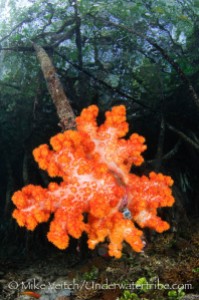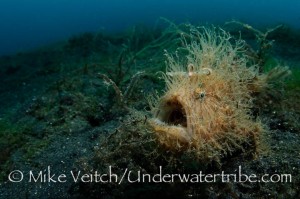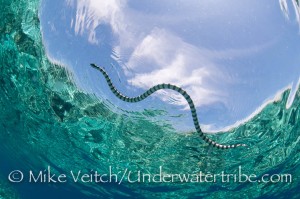The Near and Far
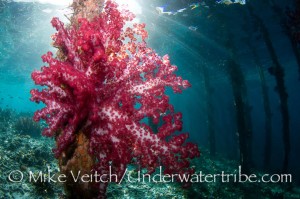 As the name might suggest, close focus wide angle (CFWA for short) is the term used for a style of photograph involving a very wide angle lens and getting as close to a subject as possible. One might wonder “why not use a macro lens if you are trying to get close to the subject?” The CFWA is a different animal than macro photography with different goals and subject matter in mind.
As the name might suggest, close focus wide angle (CFWA for short) is the term used for a style of photograph involving a very wide angle lens and getting as close to a subject as possible. One might wonder “why not use a macro lens if you are trying to get close to the subject?” The CFWA is a different animal than macro photography with different goals and subject matter in mind.
CFWA subjects are a far cry from the shrimps, nudibranches, and other small critters popular amongst macro photographers. The typical CFWA subject is a readily approachable medium sized object such as an anemone, soft coral, or certain species of fish such as lionfish or crocodilefish. It may sound like some of these subjects are too small for a wide angle lens or that these lenses are better suited to large landscape shots or creatures such as mantas or whales, not true! The great thing about most wide angle lenses is the fact they are capable of focusing mere centimeters away from the end of the port. What does this mean to the underwater shooter? Simple, you can fill half the frame with your main subject and have plenty of room to enhance the “negative” space with another subject to maximize the impact of the photo.
Here are a few tips to get you on the way to mastering Close Focus Wide Angle photography.
The foreground is key
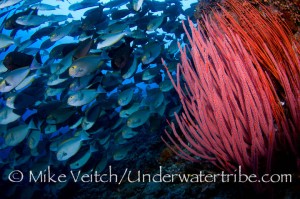 What really makes a CFWA photograph stand out is an engaging, bright, and colourful main subject. The first order of business is finding a strong subject to fill this role. We all know that sharks and mantas don’t offer close photo opportunities on every dive so the best way to start producing CFWA photos is to choose static objects to practice on in order to perfect strobe positioning and exposure. One of my favourite subjects are anemones with their myriad of colours and personable resident clownfish. The size of anemones is perfect for CFWA and when they are balled up in feeding position they make for a brilliant foreground. Other subjects that lend themselves well to CFWA photos include soft corals, sea fans, and hard corals.
What really makes a CFWA photograph stand out is an engaging, bright, and colourful main subject. The first order of business is finding a strong subject to fill this role. We all know that sharks and mantas don’t offer close photo opportunities on every dive so the best way to start producing CFWA photos is to choose static objects to practice on in order to perfect strobe positioning and exposure. One of my favourite subjects are anemones with their myriad of colours and personable resident clownfish. The size of anemones is perfect for CFWA and when they are balled up in feeding position they make for a brilliant foreground. Other subjects that lend themselves well to CFWA photos include soft corals, sea fans, and hard corals.
Get close, now get closer
 What surprises many new shooters is exactly how close you need to get to a subject to fill the frame. With a rectilinear lens such as a Nikon 12-24mm (and dioptre) or the classic Nikonos 15mm, it’s possible to get 15cm from the lens. With the ever more popular fisheye lenses, the focus is so close that you have to be careful not to bump your subject with the dome port! Getting this close to subjects means they fill the frame enough to be THE main subject and do not suffer from distracting bits of coral around the edges.
What surprises many new shooters is exactly how close you need to get to a subject to fill the frame. With a rectilinear lens such as a Nikon 12-24mm (and dioptre) or the classic Nikonos 15mm, it’s possible to get 15cm from the lens. With the ever more popular fisheye lenses, the focus is so close that you have to be careful not to bump your subject with the dome port! Getting this close to subjects means they fill the frame enough to be THE main subject and do not suffer from distracting bits of coral around the edges.
One of the benefits to CFWA shots is the opportunity to add a secondary subject to the photo, or the “near and far” approach. Due to the wide angle of the lens, the main subject often doesn’t fill the entire frame and leaves empty space around it that benefits from creative composition. This is the photos’ “negative space” and what you do with it can be the difference between a good photo and a great photo. In CFWA shots, the easiest way to gain “negative space” is to flip your camera and shoot the photo from the vertical position. When shooting vertically, there is a whole lot of blue to work with. The blue background in and of itself is a nice complement to a colourful subject but it also lends itself very well to additional elements. Two of the easiest elements to add to the background are sun rays or a diver silhouette. It’s simply a task of getting in the right position to add the sun to the frame and a few hand signals with your buddy to get him/her in the right position. Obviously there are other subjects that can be added to the background of a photo but most take a good deal of luck by being in the right place at the right time. One thing I keep in mind when I am diving in areas where “Mr Big” can be found is: “what would make an interesting foreground?” By knowing where a large piece of soft coral or sea fan is located, I can be in position to include it in the foreground of my photo when that manta or shark swims by. Although a shark on its own might be too small to fill the frame, I now have a two part photograph with a near and far subject. This photograph is visually more appealing than either subject would be on its own.
One of the most overlooked aspects of close focus photos is strobe positioning. In traditional wide angle photography, we set our strobe arms out wide to “edge light” the subject while avoiding backscatter. If you were to move in close and take a photo without adjusting the strobes you may be surprised just how dark that photo turns out! In close focus photography, having the arms out wide doesn’t work. With the dome scant inches from the subject, the light from the strobes would miss the subject entirely. One way of lighting the subject would be to leave the strobes wide and turn them to face the subject. However, this approach can lead to unsightly shadows cast upon the face of your critter. A superior way of lighting a close subject is to bring the strobes right in to the dome port and pointing them slightly outside of parallel to the lens. Not only does this avoid shadows, it also cuts down on backscatter around the edge of the frame. If using a fisheye lens, be careful when using this technique, it’s important to bring the strobes behind the plane of the camera in order to avoid strobe flare. Another piece of advice when using the fisheye lens: use a small dome port as opposed to using a “super dome”, the wide radius of these domes prove tricky when trying to aim the strobes at a subject centimeters away.
When metering for the background exposure there is one thing to keep in mind: meter the background, not the subject. First, compose your photo and set your f-stop based on the distance you will be from the subject. Next, back away a touch and aim the camera at the background in order to set the shutter speed correctly. “Backing away” is important due to the amount of light the main subject cuts off from the lens. This blocking will create a false reading in the camera and either under or over expose the background. A clear and unobstructed view of the blue water is the best way to achieve the right exposure.
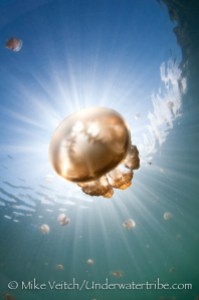 Ever wanted to get one of your photos on the cover of a dive magazine? If you look carefully at the cover of a dive magazine, the vast majority of wide angle covers feature close focus shots and they are all shot vertically! One thing a cover photo needs is a lot of space at the top of the shot and the wide view of a CFWA photo provides this perfectly. By positioning the subject in the middle to bottom third of the photo there is plenty of negative space at the top and bottom of the frame to add either a secondary far subject, or if luck is on your side, the title of a magazine!
Ever wanted to get one of your photos on the cover of a dive magazine? If you look carefully at the cover of a dive magazine, the vast majority of wide angle covers feature close focus shots and they are all shot vertically! One thing a cover photo needs is a lot of space at the top of the shot and the wide view of a CFWA photo provides this perfectly. By positioning the subject in the middle to bottom third of the photo there is plenty of negative space at the top and bottom of the frame to add either a secondary far subject, or if luck is on your side, the title of a magazine!
Mike Veitch







